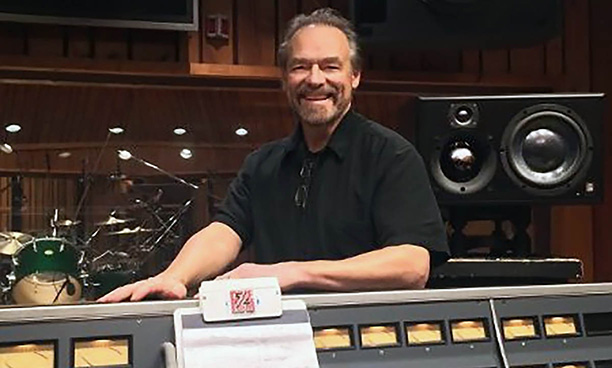
A tireless advocate of cutting-edge recording technologies, audio engineer Michael Bishop has earned ten Grammy wins in a career spanning almost 45 years. He served as the Chief Recording Engineer for Telarc Records until Concord Music Group abandoned in-house production, and is now a partner in Five/Four Productions with former Telarc colleagues, Robert Friedrich and Thomas Moore.
His most recent projects include the recording of two new pieces by Jonathan Leshnoff, a traditional multitrack studio session with Eighth Blackbird, and the hip-hop/orchestral fusion of Pharrell Williams with the Dallas Symphony Orchestra. Although he’s never advocated ‘documentary-style’ recordings, Bishop is riding the movement of traditional classical recordings towards movie soundtracks.
‘There’s a lot more activity on the engineer’s part,’ he says. ‘The audience is expecting more detail and colour, and modern composers are writing pieces that really require the microphone technique needed to capture all of the details, actions, and interactions.’
Bishop travelled to Atlanta’s Woodruff Symphony Hall – a space where he has recorded nearly one hundred times – for the world-premier recording of Jonathan Leshnoff’s Symphony No.2 and Zohar performed by Robert Spano and the Atlanta Symphony Orchestra and Chorus.
As direct-to-stereo mixes have long been a hallmark of Bishop’s work over the past few decades, he mixed all 28 microphones on stage down to stereo using DSD recording technology and his ATC SCM150ASL monitors.
‘The ATCs play a crucial role,’ he states. ‘I’m making all of my recording, mixing, and mastering decisions right there, and it is thus paramount that I have an accurate image of every detail. Moreover, the 150s have the size and presence to give the producer and conductor a true impression of the recorded piece, which closes the feedback loop and gets us to a winning take with all due speed.’
‘With ATCs, I’m able to make, say, a 1-inch change in the angle of a microphone and really hear its effect,’ he continues. ‘Most monitors gloss over that kind of detail, but those are the details that add up to a great recording. Moreover, every ATC loudspeaker, from the 20s to the 300s, provides that same consistent level of detail.’ Bishop tracked on ATC SCM25A close-field monitors at IV Lab Studios in Chicago, where he recorded the Chicago-based avant-garde ensemble Eighth Blackbird performing pieces written by five different contemporary composers for their Hand-Eye release on Cedille Records. ‘Eighth Blackbird was closer to a modern studio session, with the backbones of songs laid down, and followed by overdubs and manipulations of the recorded material as dictated by the composers.’
Bishop and long-time collaborator and former Telarc producer Elaine Martone were under pressure to work quickly: ‘The detail revealed by the ATCs greatly aided our decision making process and enabled us to make good decisions on the spot. With any recording session, there are a million things to worry about and manage,’ he says. ‘ATC’s consistency and truth remove one of the most potentially damaging variables – we’re confident that what we’re hearing is the truth. That puts Elaine in a comfortable place and lets her focus on the musical aspects. She doesn’t have to question what she’s hearing.’
Rules of the Game
The Dallas Symphony Orchestra commissioned pop artist Pharrell Williams to compose a piece that he called Rules of the Game that also involves dance, sculpture, and video. Bishop squeezed into the pit with a 28-piece chamber orchestra augmented by a hip-hop rhythm section, triggered samples, and an unusually heavy dose of percussion instruments. Of the session’s 72 tracks, 24 were devoted to percussion. Arranger and composer David Campbell, who has done similar work with Justin Timberlake, Beyoncé, and others, led the effort.
‘Working in the pit is the pits,’ Bishop says. ‘We were jammed in there, and I had to mic everything very closely. Everyone was on in-ear monitors so that they could stay in time with pre-recorded samples. It was pretty uncomfortable.’
Back in the friendlier environs of the Five/Four studio, Bishop is mixing the performance on his 5.1 set of ATC SCM150ASLs. ‘The turnaround is tight because the dance company needs the recording for performances without a live orchestra,’ he explains. ‘As always, the ATCs make it easy to mix and know that my work will translate to any system whatsoever. Since moving to ATC seventeen years ago, I’ve never been surprised by what a mix sounds like on a different system.’









